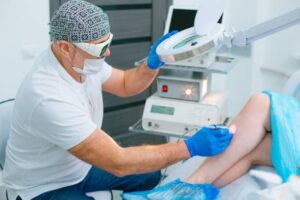Varicose veins can be an indicator of more serious medical conditions. Weakened valves allow blood to accumulate in your legs and cause the veins to swell up, often leading to visible symptoms of varicose veins.
By visiting varicose vein treatment clinic Adelaide, you can get conservative treatments that may provide relief from symptoms of pain, itching and swelling. Non-invasive strategies like compression stockings or elevating legs may increase blood flow to veins that become enlarged over time and prevent their expansion.
Sclerotherapy
 Sclerotherapy is an effective solution to unwanted small blood vessels and spider veins. A doctor injects a chemical solution directly into these veins, which causes them to close up over time. This procedure takes place without the use of anaesthesia and takes only minutes at your provider’s office.
Sclerotherapy is an effective solution to unwanted small blood vessels and spider veins. A doctor injects a chemical solution directly into these veins, which causes them to close up over time. This procedure takes place without the use of anaesthesia and takes only minutes at your provider’s office.
Sclerotherapy injections may feel similar to mild stinging or burning sensations and require two to three sessions for optimal results. Unfortunately, pregnant women, people who have had blood clots in the past or those taking birth control pills cannot undergo the procedure.
Doctors also employ sclerotherapy to treat grade 1 and 2 haemorrhoids (blood vessels that swell to make bowel movements painful) as well as hydroceles (collections of fluid around testicles). While insurance doesn’t generally cover this treatment option, sclerotherapy is far less costly than surgery.
Phlebectomy
Surgery may be used to address very large and bulging varicose veins, as well as grape-like clusters of varicosities that don’t respond well to sclerotherapy or radiofrequency ablation.
Your vascular surgeon will first mark and numb the treatment area with local anaesthesia before performing minimally invasive varicose vein removal with small incisions that look similar to slits in skin, followed by use of an instrument similar to a hook for pulling varicose veins out.
Your varicose vein treatment clinic Adelaide doctor may need to make multiple incisions to fully remove a varicose vein. He or she will then tie off its end; however, blood will continue to flow normally due to veins deeper within your leg taking over this function.
Radiofrequency ablation
With this non-invasive procedure, a vein specialist uses ultrasound imaging to locate diseased veins. He or she then administers Clarivein medication directly into these unhealthy veins in order to irritate their walls and redirect blood flow towards healthier leg veins.
This treatment also delivers cosmetic results by eliminating spider and varicose veins from your legs, as well as relieving any pain caused by them.
Your vein doctor may request that during laser ablation, you temporarily discontinue taking blood-thinning medications or aspirin. When discussing these changes with the medical team who manage your diabetes or insulin medication, your vein doctor can review your medical history to provide a more accurate forecast as to when pain relief will begin and last.
Endovenous laser ablation
Your legs serve as highways to deliver oxygen-rich blood pumped by your heart to all parts of your body. Over time, however, these veins can become twisted and bulging and cause pain; varicose vein ablation (EVLT) is an office procedure which uses laser energy to close these swollen and uncomfortable veins with precision.
Your doctor will use ultrasound imaging to locate the problem vein. They’ll make a small incision near it and insert a thin catheter, which they guide directly toward diseased veins which they cover with medical-grade adhesive called VenaSeal.
After your procedure from varicose vein treatment clinic Adelaide is over, you should be able to resume normal activity and return home the same day. Although you may experience some temporary bruising or swelling at the site of treatment, which should resolve within one or two weeks.
VenaSeal
VenaSeal, often referred to as “super glue,” is an emerging treatment option for varicose veins. The process entails injecting medical-grade adhesive directly into damaged veins in order to close them and allow blood flow through nearby healthy veins instead of into them; with time the affected vein will fade and disappear completely. Compared with ablation treatments which use heat sources there’s no risk of burns or bruising with this approach.
At our facility, we perform this procedure using ultrasound imaging to locate damaged veins and guide a catheter into their path. Once adhesive is injected into a damaged vein, it will close off and divert blood away to nearby healthy vessels – without needing tumescent anaesthesia or compression stockings that many patients find uncomfortable, hot and difficult to manage.